FREE Ohio DMV Practice Test #12
The practise exams for Ohio's DMV have been revised for January 2026. It comprises questions based on the most important traffic signals and laws for 2026 from the Ohio Driver Handbook. To study for the DMV driving permit test and driver's licence exam, use actual questions that are very similar (often identical!) to the DMV driving permit test and driver's licence exam.
Each question on the practise exam has a tip and explanation to help you recall the ideas. Questions about traffic rules, traffic signs, and driving statutes, as well as knowledge from the Driver Handbook, will be included in the written portion of the official Ohio DMV test.
You must properly answer 35 of the 40 questions to receive a passing mark. To help you prepare for your instruction permit or driver's licence, take this practise test from the Ohio Department of Motor Vehicles.
The DMV exam is offered in a variety of languages.
Using any form of testing help will result in an automatic fail, and the DMV may take further action against your driver's licence, so avoid it.
1 . When approaching railroad tracks, you should:
When approaching railroad tracks, you should look, listen, slow down, and be prepared to stop for trains or other vehicles that may be using the rails.
2 . You may continue carefully through an intersection with a yellow light if:
If a steady yellow light appears when you are already within an intersection, you should continue through the intersection carefully.
3 . The most effective thing you can do to reduce your risk of being injured or killed in a traffic crash is to:
Wearing your seat belt is the single most effective thing you can do to reduce your risk of death or injury while driving.
4 . To prevent hydroplaning, you should:
To prevent hydroplaning, you should ensure that the tires on your vehicle have good tread depth and are inflated to the proper pressure. Reduce the speed of your vehicle when driving in the rain. Hydroplaning occurs most frequently at higher speeds.
5 . This sign means:

Warning signs are usually diamond-shaped with black markings on a yellow background. They alert drivers to upcoming hazards. This sign indicates that the divided highway is about to end.
6 . This road sign means:

This sign indicates that there is a sharp right turn ahead.
7 . Taking drugs along with alcohol:
Drugs (including illegal, prescription, and over-the-counter medications) can affect your brain function and impair your ability to drive safely. Combining alcohol with other drugs will increase the risk of a crash.
8 . When you see this black and yellow sign, it means:

This sign indicates that the road ahead changes direction at an extreme angle (in this case, to the right). Before you reach such an extreme curve, you should slow down as much as you would when making a turn at an intersection.
Need Car Insurance? No problem!
Compare the best rates in Ohio and find a personalized policy that meets your needs.
1. Are You Currently insured ?
2. Married ?
3. Do you own your Home?
4. Do you have more than 1 car ?
5. Have you or a Family Member Honorably Served in U.S. Military ?
6. Your Name
7. Age
8. Zip code
IMPORTANT REMINDER:Auto Insurance is Mandatory to drive in Ohio. Get covered before you hit the road to avoid any fines.
Ranked by best match



